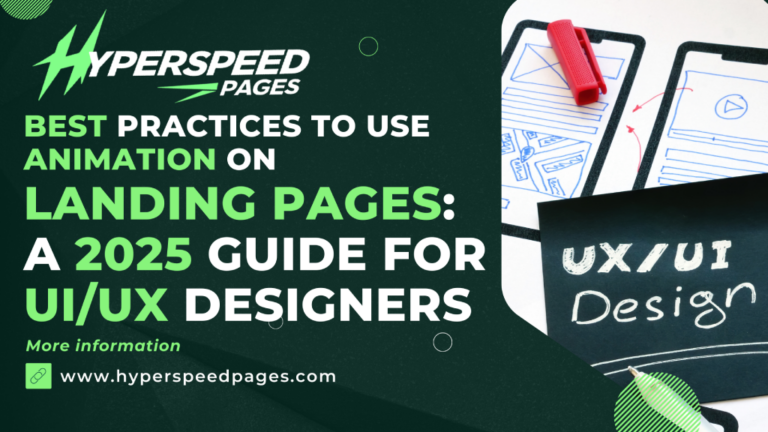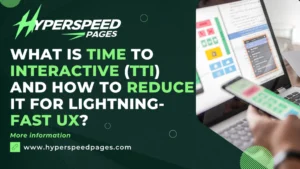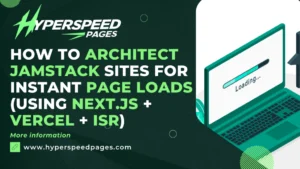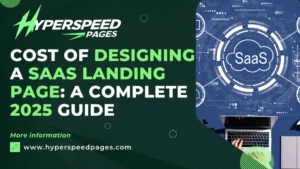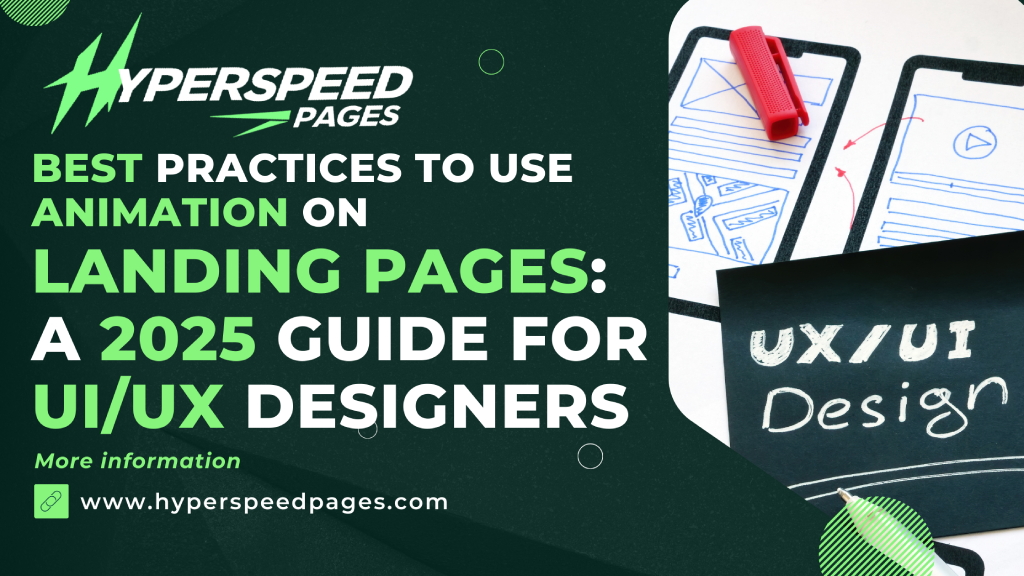
As a UI/UX designer, you’re likely no stranger to the power of animation in enhancing user experience and driving engagement. When used thoughtfully, animation can elevate your landing page from bland to grand, capture visitors’ attention and motivate them to take action.
Landing pages serve as the gateway to conversions, but in a digital world filled with fleeting attention spans and rising expectations, static design no longer makes the cut. Animations, when used strategically, can transform static pages into dynamic experiences that drive engagement, enhance usability, and boost conversion rates.
The Psychology of Animation: Understand User Perception
Our brains process visual information in a specific way, and animation can significantly influence this process.
- Attention-grabbing: Animation can draw attention to specific elements on the page, guiding the user’s focus and improving overall engagement.
- Emotional connection: Animation can evoke emotions, creating a connection between the user and the brand. This emotional resonance can increase user investment and motivation.
- Storytelling: Animation can be used to tell a story, conveying complex information in an engaging, easy-to-understand format.
Visual Communication at a Glance
Users expect clarity, immediacy, and visual storytelling. Micro-animations, scroll-based effects, and interactive transitions serve as visual cues that:
- Increase conversions by 20-30% (Baymard Institute, 2024)
- Reduce perceived load time by 40% (Google UX Research)
- Improve message retention by 70% (Nielsen Norman Group)
Improved Engagement Metrics
Animated elements improve engagement KPIs such as:
- Time on page
- Click-through rate (CTR)
- Scroll depth
- Form submission rate
Key Psychological Effects
- The Zeigarnik Effect: Users remember incomplete actions (e.g., a loading animation keeps them engaged).
- Chunking Principle: Animated sequences help users process information in digestible steps.
- Hick’s Law: Well-timed animations reduce cognitive overload during decision-making.
When to Use (and Avoid) Animation
Best Use Cases for Landing Page Animation
- Hero section introductions (e.g., a smooth fade-in for value propositions)
- Interactive CTAs (hover effects, micro-interactions)
- Progress indicators (for multi-step forms)
- Storytelling sequences (scroll-triggered animations)
- Visual feedback (form validation, button clicks)
When to Avoid Animation
- Excessive decorative motion (distracts from core messaging)
- Auto-playing videos (hurts performance & accessibility)
Strategic Animation Types for Landing Pages
1. Micro-Interactions
Small-scale animations triggered by user input (e.g., hover, tap, click).
Examples:
- Button hovers with subtle bounce or scale
- Like/heart icons with a pulse animation
- Progress bars or toggles with movement feedback
Best Practices:
- Keep duration <200ms for responsiveness
- Use easing functions like ease-out for natural feel
- Ensure keyboard accessibility (focus states)
Best Practices:2. Hero Section Animations
Animations in the hero section define first impressions.
Examples:
- Typing effects for value propositions
- Lottie animations representing product benefits
- Entrance fades or slide-ins for images and headlines
Best Practices:
- Avoid blocking interaction with long intros
- Ensure animations don’t hinder Largest Contentful Paint (LCP)
- Animate only essential elements above the fold
3. Scroll-Triggered Animations
Reveal-on-scroll or parallax animations are effective for storytelling and content flow.
Examples:
- Elements fading in sequentially
- Background image parallax with layered content
- Infographics that animate as they come into view
Best Practices:
- Use Intersection Observer API for optimal performance
- Limit animation triggers to once per session or viewport
- Test for accessibility and ensure motion is not disorienting
4. Loading and Transition Animations
Reduce perceived load time and maintain user context during navigation.
Examples:
- Skeleton loaders with shimmer effects
- Animated loaders with branding cues
- Smooth page transitions in SPAs (Single Page Applications)
Best Practices:
- Keep spinners under 1.5 seconds, or use skeletons for longer loads
- Always provide fallback content for JavaScript-disabled users
- Maintain state persistence on navigation
Cognitive UX: Animation & User Perception
- Predictability: Use consistent motion patterns to create learnable experiences.
- Hierarchy: Motion can guide focus from primary to secondary content.
- Feedback: Visual feedback reduces uncertainty in form submissions and navigation.
Pro Tip: In usability testing, observe whether animations reinforce or distract from user goals. The more intuitive the experience, the more seamless the animation integration.
Performance Optimization for Animated Landing Pages
Performance is crucial, Google Core Web Vitals and UX are inseparable in 2025.
Key Metrics to Watch:
- LCP (Largest Contentful Paint): Delay-heavy animations can impact score.
- FID (First Input Delay): Interactive animations must be non-blocking.
- CLS (Cumulative Layout Shift): Avoid animations that alter layout dimensions on load.
Tools:
- Lighthouse
- WebPageTest
- Chrome DevTools → Performance Tab
- GSAP + Lottie for performant animation handling
Best Practice: Offload animation processing to the GPU using transform and opacity instead of layout-triggering properties like width, height, top, left.
Accessibility and Compliance
Requirements for 2025:
- Provide a “Reduce Motion” option via prefers-reduced-motion media query
- Avoid auto-playing animations that flash or blink more than 3 times per second
- Ensure motion does not trigger vestibular disorders or cognitive fatigue
Tools & Frameworks to Build Scalable Animations
| Tool / Library | Use Case | 2025 Status |
| GSAP | High-performance animations with fine control | Still industry-leading |
| Lottie | Lightweight JSON-based animations from After Effects | Enhanced React & Vue support |
| Framer Motion | Declarative React animations | Preferred for React SPAs |
| Three.js | 3D interactive web animations | Use selectively to avoid heavy payloads |
| Spline | Web-based 3D design tool | Rising in UI motion prototyping |
A/B Testing Animation Impact
Always test assumptions. Use A/B or multivariate testing tools like:
- Google Optimize (sunsetting, consider Optimizely or VWO)
- Convert.com
- PostHog with session replay
What to Test:
- With vs. without hero animations
- Fast vs. slow micro-interactions
- Static vs. animated CTA buttons
Conversion-oriented Animation Tips
- Keep CTA animations subtle but inviting: Pulse, bounce, or color shift
- Animate trust signals or testimonials on scroll
- Use storytelling animation to guide users through product benefits
Avoid:
- Excessive motion that delays conversion
- Distracting looped animations
- Animation without clear UX purpose
Best Animation Tools for Landing Pages in 2025
a) GSAP (GreenSock Animation Platform)
- Best for: High-performance animations with full control
- Why It’s Powerful: GSAP remains the gold standard for animating DOM elements, SVG, canvas, and WebGL. It’s battle-tested, performant, and offers precise control over timelines, easing, and sequencing.
Key Features:
- Zero-dependency, modular architecture
- GPU-accelerated animations for smooth transitions
- MorphSVG, ScrollTrigger, and MotionPath plugins
- Compatible with React, Vue, Angular
2025 Updates:
- GSAP 4.0 introduces scroll snapping, smoother physics-based motion, and expanded WebGL support.
Use Case Example: Use GSAP with ScrollTrigger to create immersive hero animations or staggered content revealed on scroll.
b) Framer Motion (React-Based)
- Best for: Declarative animations in React projects
- Why It’s Powerful: Framer Motion is tailor-made for modern React-based top saas landing pages. It provides intuitive APIs for layout animations, shared transitions, and gesture interactions, all with excellent defaults.
Key Features:
- AnimatePresence for entrance/exit transitions
- Layout animations with shared layout IDs
- Spring and tween animations with ease-in/out controls
- Drag, hover, tap animations natively supported
2025 Updates:
- Native support for React Server Components and React 19
- Integration with Framer Sites for visual-to-code handoff
Use Case Example: Animate call-to-action buttons and modal transitions using layout-aware motion components.
c) Lottie by Airbnb
- Best for: High-quality vector animations exported from After Effects
- Why It’s Powerful: Lottie allows designers to export animations as JSON from Adobe After Effects (via Bodymovin plugin), rendering them in the browser using native vector formats.
Key Features:
- Small file size (JSON over GIFs/videos)
- Scalable across screen sizes and densities
- React, Vue, Web, iOS, and Android support
- Play on scroll, hover, or click
2025 Updates:
- Real-time animation customization API (text, colors)
- New LottieFiles visual editor for no-code animation tweaks
Use Case Example: Use Lottie for animated success icons, loading indicators, or onboarding steps.
d) Spline
- Best for: 3D interactive animations in modern interfaces
- Why It’s Powerful: Spline offers a no-code interface for designing and exporting interactive 3D web experiences. The output is embeddable and optimized for real-time interaction.
Key Features:
- Real-time 3D canvas with lighting, shadows, and depth
- Interactivity triggers (hover, click, drag)
- Figma plugin + Webflow export compatibility
- Embeds via iframe or code export
2025 Updates:
- WebGL 2 support with improved texture loading
- Full support for animation states and scripted interactions
Use Case Example: Design animated 3D product showcases or immersive explainer sections in your hero block.
e) Motion One (by the creators of Framer)
- Best for: Lightweight, fast JavaScript animation library
- Why It’s Powerful: Motion One offers modern CSS animation APIs with fine control, ideal for teams that want GSAP-like power in a much smaller package (~4kb).
Key Features:
- Native animation with hardware acceleration
- Supports timelines and scroll-based triggers
- Fastest startup performance in benchmark tests
- JSX-friendly for modern frontend workflows
2025 Updates:
- Improved SVG and path support
- Integrated with native Web Animation API enhancements
Use Case Example: Use it for fast animations in landing pages where performance is paramount (e.g., mobile-first experiences).
f) Webflow
- Best for: Visual animation without code
- Why It’s Powerful: Webflow empowers designers to build visually rich amazon landing page builder with motion and interactions, without writing a single line of code.
Key Features:
- Scroll, click, and hover animations via UI
- Exportable clean HTML/CSS/JS
- CMS animation triggers
- Timeline-style editor with responsive previews
2025 Updates:
- Enhanced animation trigger logic (multi-condition support)
- Live collaboration and Git export for dev handoff
Use Case Example: Rapid prototyping and testing animated landing pages in real-time.
Evaluation Criteria: How to Choose the Right Tool
| Criteria | Best Tools |
| Performance (Core Web Vitals) | GSAP, Motion One |
| Ease of Use | Lottie, Webflow |
| Developer Flexibility | GSAP, Framer Motion |
| Design-to-Code Handoff | Lottie, Framer, Webflow |
| 3D Experience | Spline |
| React Ecosystem Integration | Framer Motion, Motion One |
Integrating Animation Tools into Your Workflow
Design System Integration
- Use animation tokens in your design systems (duration, easing, delay)
- Document motion principles, when and how animations should be applied
- Standardize reusable components with built-in animation states
A/B Testing and Performance Monitoring
- Use PostHog, VWO, or Optimizely to test animation impact on UX
- Monitor page load and interactivity using Core Web Vitals dashboards
Final Takeaways for UI/UX Teams
- Match the tool to your team’s strengths, designer-led? Webflow. Developer-heavy? GSAP or Motion One.
- Start small, focus on micro-interactions and CTA animations before scaling up.
- Prioritize accessibility and performance, animation should enhance, not hinder.
- Leverage frameworks, integrate with React, Vue, or static site generators for modern deployment.
Landing page animation is no longer about flashy gimmicks but clarity, delight, and usability. Ready to make your landing page motion-optimized? Explore our UI/UX animation consulting services or book a free animation audit today.
Final Checklist: Animation Best Practices for 2025
- Respect user intent and motion preferences
- Optimize for performance and Core Web Vitals
- Use animation to reinforce, not replace content
- Align motion with brand tone and hierarchy
- Prioritize accessibility (WCAG-compliant)
- Document and systematize animations in your design system
Conclusion: Animation as a Strategic UX Tool
In 2025, animation on landing pages is not just about aesthetics—it’s about communication, efficiency, and experience design. The most effective UI/UX teams use animation with surgical precision: to reduce friction, increase conversions, and delight users without overwhelming them.
By following the practices outlined above, you can turn your landing pages into high-performance experiences that convert and communicate with clarity.

